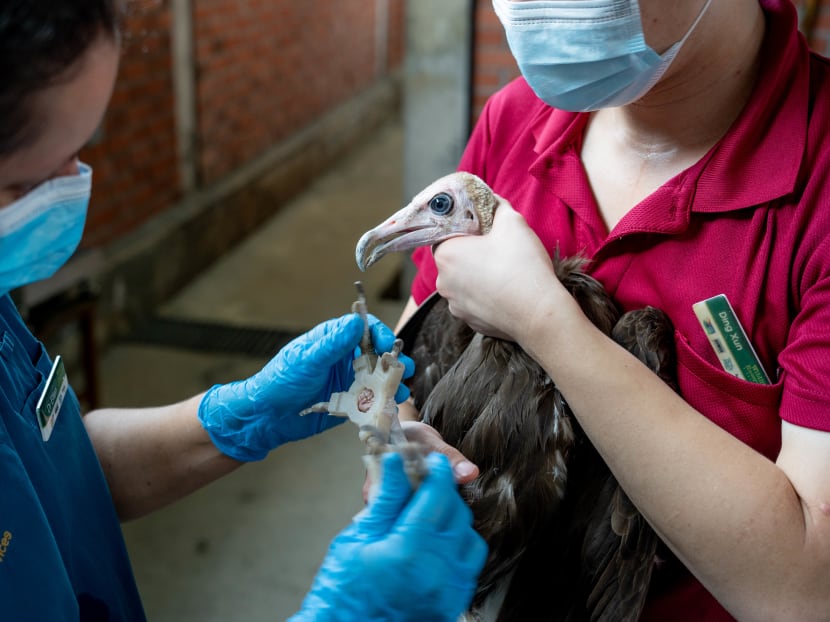3D-printed shoes give ageing birds a new lease of life
SINGAPORE — Two ageing birds of prey afflicted with a foot disease known as “bumblefoot” have successfully recovered from their condition with the help of 3D-printed shoes.

A hooded vulture from Jurong Bird Park wearing customised silicone shoes cast from 3D-printed moulds of its feet.
- Birds of prey suffering from a condition known as “bumblefoot” have been successfully treated with 3D-printed shoes
- The treatment involves creating customised silicone shoes cast from 3D printed moulds
- It is a result of a two-year collaboration between the Jurong Bird Park and the Keio-NUS Cute Centre
SINGAPORE — Two ageing birds of prey afflicted with a foot disease known as “bumblefoot” have successfully recovered from their condition with the help of 3D-printed shoes.
The novel treatment — which involves creating customised silicone shoes cast from 3D-printed moulds of the birds’ feet — is a result of a two-year collaboration between the Jurong Bird Park’s avian veterinary team and the Keio-NUS Cute Centre of the National University of Singapore’s (NUS).
Bumblefoot, also known as pododermatitis, causes pressure sores, tissue swelling and callouses. If left untreated, it could become disabling and even fatal for birds.
Birds that tend to spend longer periods perched on their feet are prone to the condition, because the continual pressure and weight on their feet can cause sores and swelling.
Arthritis, which is common in old birds, can also lead to pododermatitis.
Dr Xie Shangzhe, acting deputy vice-president for conservation research and veterinary at Mandai Wildlife Group, which runs the Jurong Bird Park, said: “While pododermatitis can be treated with traditional bandages, we wanted a more bespoke and innovative solution.
“We decided to look into 3D printing because it provided a more precise way of distributing the force that the feet have to bear, away from the affected area.”
In a joint media release on Thursday (Nov 25), Jurong Bird Park and NUS shared more details of the two feathered “patients” who received the customised shoes.
The first was a 21-year-old female hooded vulture named Walter.
After recovering from an earlier shoe treatment that lasted 17 weeks in 2019, Walter was released to the wildlife park’s Birds of Prey aviary.
But love had other plans. She started displaying courtship behaviour with another bird and prepared a nesting area on a hard, high rock ledge where she spent an extended amount of time perching, causing her bumblefoot to recur.
She was once again fitted with the shoes and put under observation from August to October this year.
Her symptoms improved and the shoes have since been removed. She will be discharged from her observation ward into a special aviary for retirees.
In August, a 31-year-old male Southern caracara named Miguel was also fitted with its own shoes.
Miguel, which developed pododermatitis due to arthritis from his advanced age, saw improvement after two-and-a-half months of wearing the shoes. The shoes have since been removed and it has also been discharged into the retirement aviary.
In designing the birds’ shoes, the Keio-NUS Cute Centre’s team had to factor in considerations such as the ability to relieve and distribute pressure on the bird’s weight-bearing foot.
The shoes also had to be comfortable, easily removed and cleaned, and be made of non-toxic and durable material since the birds may pick at them with their beaks.
Keio-NUS Cute Centre’s co-director Yen Ching-Chiuan said that 3D printing gave the team the flexibility to customise the shoes according to the varying sizes, shapes and conditions of each bird’s foot.
This is not the first time that the Jurong Bird Park and the Keio-NUS Cute Centre have collaborated on 3D-printing technology for veterinary care.
In 2018, the centre designed and fitted a 3D-printed prosthetic casque for a great pied hornbill, which had its casque — the helmet-like structure on its beak — removed due to cancer. The hornbill has since made a full recovery and no longer needs the prosthesis.
Dr Xie said: “The possibilities are far reaching when the engineering and veterinary sciences come together to work on real-world solutions.”






